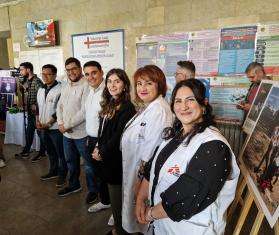
The families served are primarily Syrian refugees. Many are marginalized and cut off from health care. Children, naturally, are the most vulnerable among them.
More recently, I have been assisting the team in Zahle from a distance. Through MSF's remote consultation service, I help to direct the appropriate referral of Syrian refugee children with a wide range of complicated surgical needs. Having worked inside Syria in 2013, I am well aware of how challenging it has been to obtain health care within the country since the civil war. As you’ll read in this issue of Alert, MSF teams are doing their best to reach as many children as possible inside the country. In northern Syria, teams conduct mass vaccination campaigns to ensure that children are immunized against diseases like measles and polio, which have re-emerged in the war-torn country.
MSF’s support for vulnerable people on the move extends well beyond Syria. In Mexico, MSF teams are broadening the scope of medical services to people fleeing horrific violence in Central America, providing care at various points along the migration routes. Among the primary needs is mental health counseling, due to the significant stress related to violence inflicted upon them at home and while on the run. For women, treatment often includes helping them cope in the aftermath of sexual violence. Our clinicians also try to provide primary care for treatment of acute conditions and chronic diseases where possible. As you will read in these pages, most people in transit from Central America are regarded as economic migrants, rather than as refugees fleeing for their lives and enduring a humanitarian crisis. Many are detained and deported by Mexico and the United States, rather than protected. In May, MSF released a detailed study based on comprehensive medical data gathered from migrants and refugees from the Northern Triangle of Central America (El Salvador, Honduras, and Guatemala). The picture is alarming: almost 40 percent of those surveyed reported direct attacks, often carried out by gangs; 69 percent reported being victims of violence while on the move in Mexico. This type of expert witnessing is part of MSF’s core mission: to share medical data that provide evidence of acute humanitarian crises.
MSF’s support to people uprooted from their homes is often innovative and adapted to the specific needs and unique circumstances of patients. A small team of designers, engineers, and technologists based in Nairobi, Kenya, comprise MSF’s “displacement unit,” which finds creative ways to conduct telemedicine, alert people on the move to medical services, provide alternative cooking fuels to displaced people, and design medical “go-bags” that can be deployed at a moment’s notice when people have to flee. The displacement unit’s work is described in detail in these pages, and I hope you’ll agree that its work is both vital and inspiring.
We are also expanding outreach to the American public. This fall, we are back on the road with Forced From Home, MSF-USA’s traveling exhibition designed to draw attention to the global refugee crisis. Details of the tour are listed at the end of this issue of Alert. For those of you in the cities we’ll be visiting, I hope to see you there.
Sincerely,
JOHN P. LAWRENCE, MD
President, MSF-USA Board of Directors




